How to Find Great Blog Topics to Write About
Content is king. But only if you know what type of content and what blog topics to write about.
Finding content ideas is one of the challenges of a content creator. Before we dive into how to find great blog topics. Let’s discover what to consider when finding blog topics.
So that you don’t just create content for the sake of creating. But you’re creating content that matters to your audience.
What are some considerations when finding blog topics?
Your Audience
Who is your audience? You have to be clear about who are you creating content for? Who do you serve?
The more you specific it, the easier it would be for you finding a blog topic.
One way to do this is by developing your audience persona.
Audience persona is a fictional representation of your audience. Either you draw a person or simply just state what does this person looks like.
The more specific your audience, the better off it would be in content creation. Where does this persona work? Does he or she have kids? How old is she? Where does he or she live? What challenges might he or she have in life or in business?

Besides audience targeting, the next thing you want to consider is traffic potential.
Traffic Potential
When finding blog topics, you have to ask this question: is there enough traffic for this topic?
The reason you want to ask this is to know if there are people who are interested to learn about the topic. Because chances are you may be creating content for a topic that no one cares about.
Thirdly, you want to consider is ranking difficulty.
Ranking Difficulty
“Can I rank for this topic?”
By rankings, to be particular is search rankings.
Because if the blog topic you choose has enough search traffic, and you can compete with pages that are specifically ranking for a keyword, you can gain more visibility from rankings itself.
Now that we’ve discussed audience targeting, traffic potential, and ranking difficulty, let’s proceed to how you can find great blog topics to write about.
How to Find Great Blog Topics to Write About
First on the list is:
Use tools to discover keywords with search traffic.
The easiest way to find great blog topics is to use tools. And not just using tools, but tools that can help you discover what topics people are searching for.
Ahrefs' Keyword Explorer
First, is you can use Ahrefs. It has its feature: Keyword Explorer, which can help you find keywords people are searching for in your industry.
So you simply go to Keyword Explorer, type in any keyword or topic related to your space, then it will show you keywords related either containing the exact phrase you search for and have similar phrases to that.
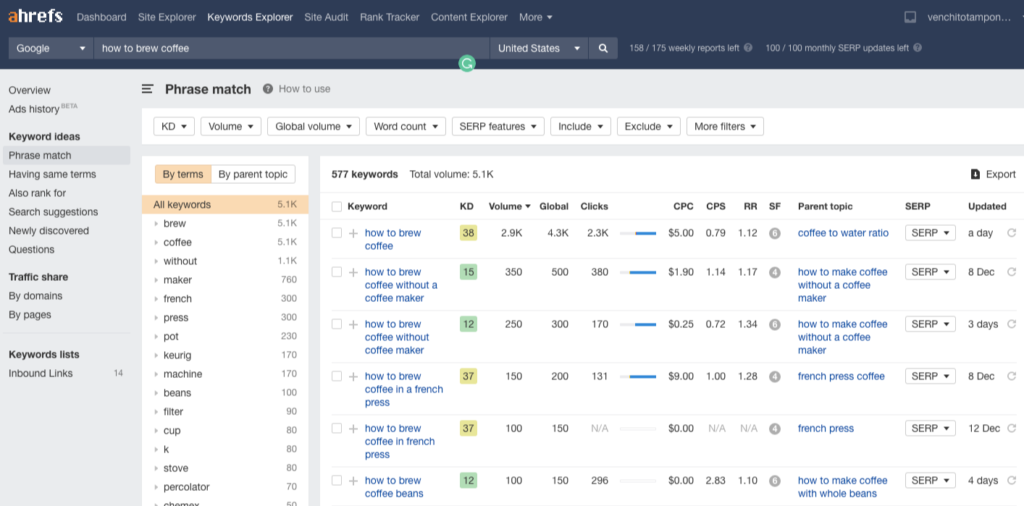
Once you have a list of keywords, what you want to see is their traffic potential. Search volume is what you have to consider here. The higher search volume for the keyword, the more people are searching for it -- which means a great blog topic to choose from.
Next thing is you want to know is if you can rank for the keyword, which we talked about earlier: ranking potential.
Ahrefs’ Keyword Explorer gives you “keyword difficulty” which tells how difficult to rank for a keyword. It considers how strong and authoritative competing pages for that keyword. The lower the keyword difficulty, the easier it is for you to rank, and therefore, a great blog topic to consider.
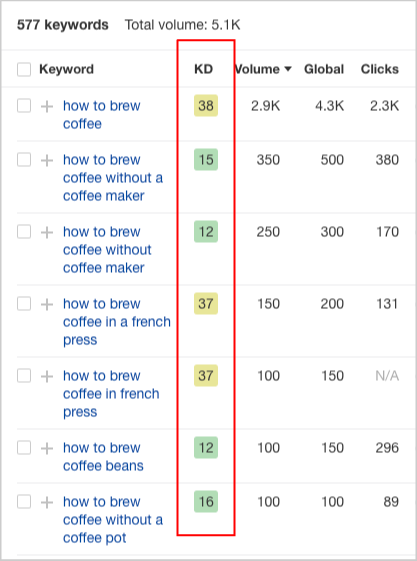
If you want to go deeper to ranking difficulty, you could also check how many links are pointing to each page ranking for the keyword.
Because the more links are pointing to each of the ranking pages, the more difficult it is to rank for the keyword. Of course, it’s not quantity of links, but also the quality of links. If the pages are getting links from trusted websites, the more difficult it is to rank for the keyword.
Exploding Topics
Aside from Ahrefs, another tool that you can use is Exploding Topics.
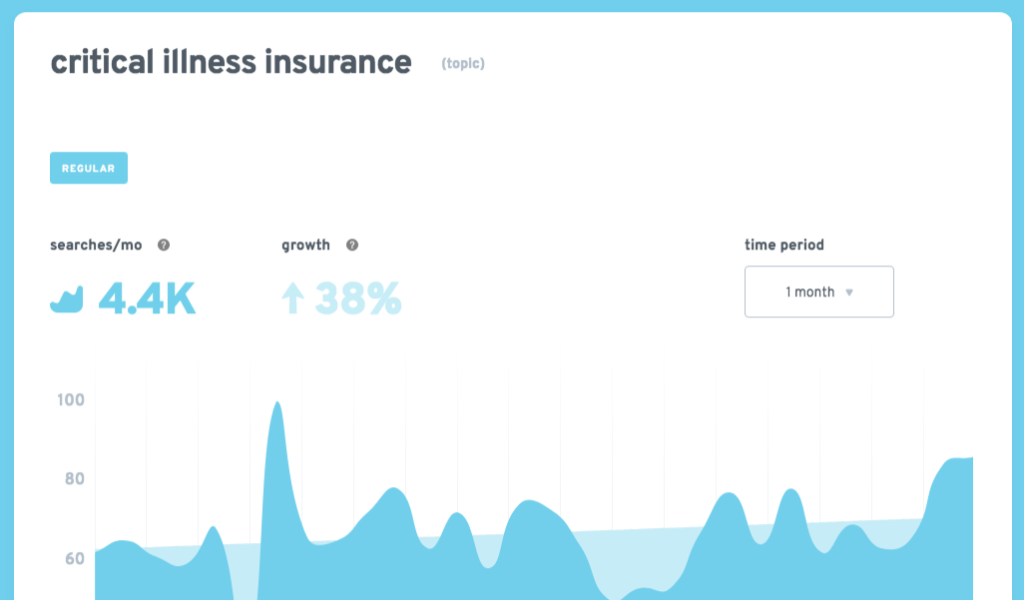
Created by Brian Dean of Backlinko, Exploding topics can help you discover the hottest new trends in different industries.
Just go over to Exploding Topics. Choose the category that fits you and the time period to see how trending the topic is for 1 month or 3 years, let’s say.
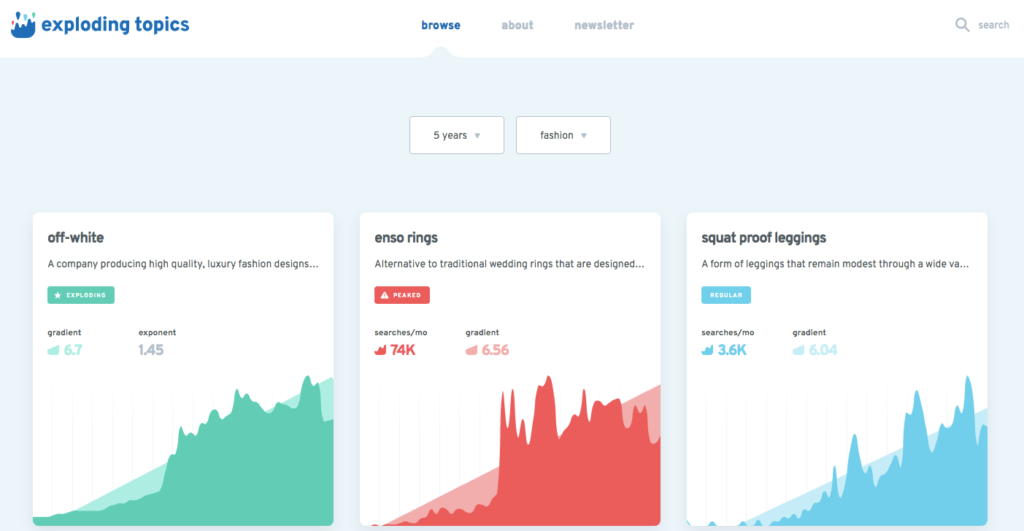
Another tip for you to find great blog topics to write about is to listen to your audience.
Listen to your audience
And by listening to your audience, it means that you go where they hang out online.
You listen to what they say, to what they voice out, to what questions they ask and what topics they care about.
One website you can go to frequently is Reddit.
So in Reddit, there are subreddits for different markets.
You search for the topic of your choice, then it would give its suggested subreddits.
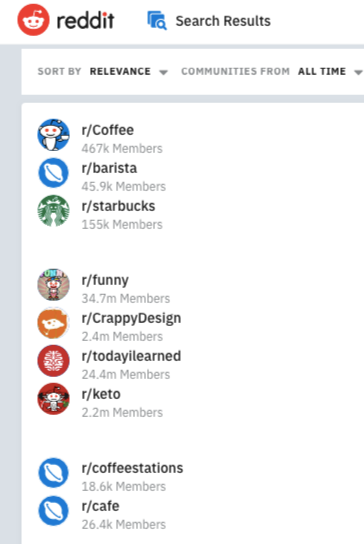
You visit each subreddit and see from time to time what questions people ask in the platform. By simply reading the questions and comments, you’ll have ideas of topics they truly care about.
So instead of just creating content and wondering if there would be people who would promote, why not start by listening to your audience and creating content to serve what they really need.
And last strategy is find great blog topics is to model topic templates.
Model Topic Templates
There are specific topics and titles of content that are common to every industry, because it speaks of needs and wants of audiences.
I call this as “topic templates”.
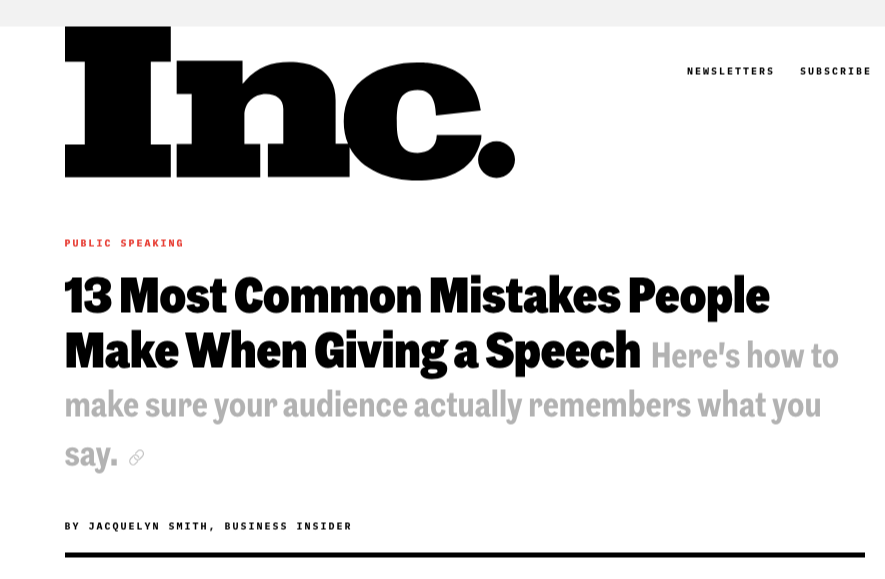
Here are some topic templates:
- 10 Common Mistakes [Audience] Make When [Action]...
- Top 3 Secrets to [Result 1]
- How to be a Highly [Result 1] Person
- 5 [Industry] Predictions in [Year]
So there are just a few examples of topic templates you can leverage for your blog. So go ahead and use any of these titles as ideas for your future content.
Let me know in the comments section what your biggest takeaway. As always, be sure to subscribe to our newsletter for more content marketing and link building tips.
How to Ethically Steal Your Competitors' Backlinks
Why competitors backlinks?
First off, we have to understand the reason why links from competitors are good types of links.
Let me give you two main reasons.
First is that these competitors' backlinks are niche relevant.
So if you’re an absolutely beginner, you want to be looking for websites that are topically relevant to your brand.
And given that those publishers and bloggers linked to your competitors, and you directly compete with your competitors, chances are what you’ll be getting from your competitors are directly connected to your blog topics.
Relevance is a critical success quality factor in backlinks. And this is something you should always consider when you try to build backlinks to your website.
Second, not only that these competitor backlinks are niche relevant. But they are also easy to prospect.
When you are prospecting for backlink opportunities, you’re likely to be using Google with advanced search operators and phrases to help you find pages on the search results that best suits your prospecting needs.
But in the case of reverse engineering your competitors’ links, you only have to use a simple tool to find all pages that linked to your competitors.
So let’s jump into how you can get your competitors' backlinks.
How to Ethically Steal Your Competitors' Backlinks
There are three steps that you can choose from based on where you’re at right now.
Find your competitors' top linkers.
The top linkers are not the ones who linked to a website once. They are the linkers who repeatedly link to pages of websites because they found value in those content.
So how can you find these top linkers who constantly link to your competitors?
Get the domain of your competitor’s website. Plug it into Ahrefs’ Link Explorer.
We’ll use Tuck, a sleep product review website as our example.
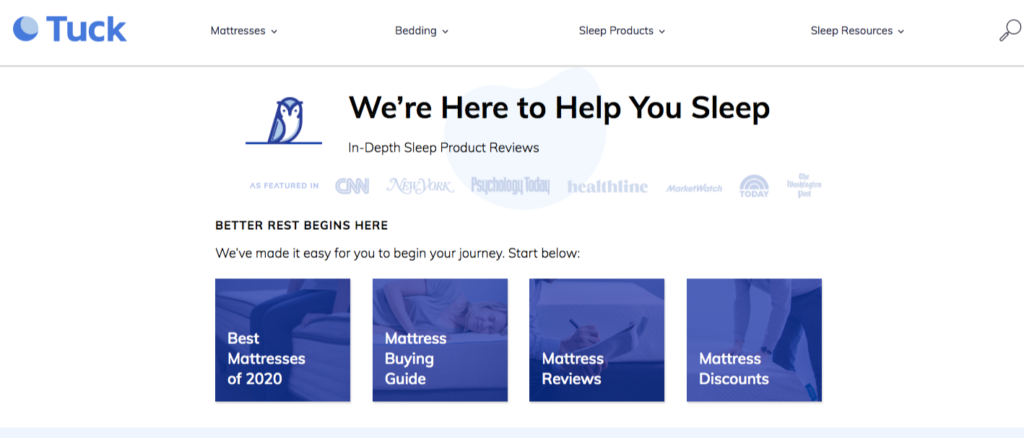
I’ll get tuck.com and plug it into Ahrefs’ Link Explorer. On the Backlinks area, right at the Backlink Profile section, I’ll be able to see all the websites that linked to tuck.com
As of this recording, there are 9,620 unique websites linking to Tuck.

That’s a lot!
So out of these 9 thousand plus linking websites, how can you find the quality prospect websites you should be looking for.
And not only that, how can you find those top linkers who repeatedly link to the Tuck website.
Here’s a strategy that you can follow.
Get all of the top 10 to 20 pages of your competitor.
On Ahrefs, you can see it either on the Top Pages section or Best by Links section.
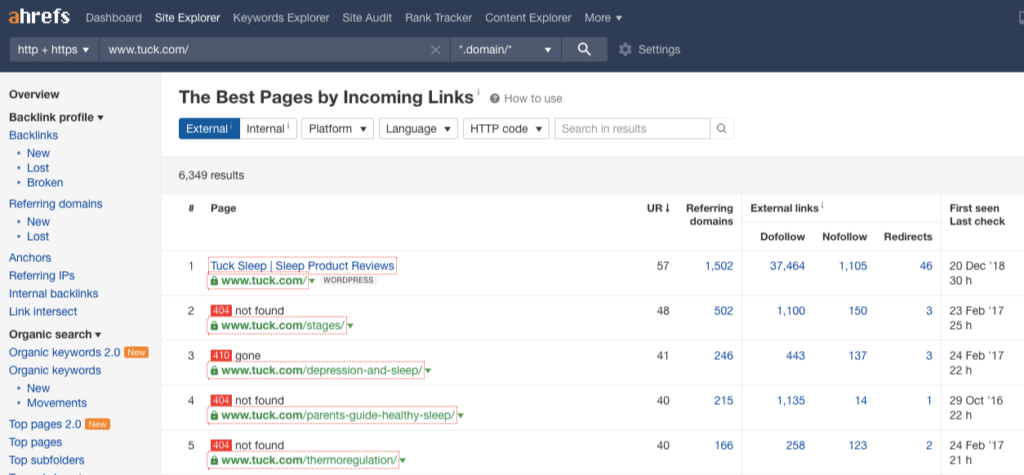
The next thing you want to do is to use Link Intersect to see the websites to at least two of the top pages of your competitor.
So first is to insert all top pages in Link Intersect one by one.
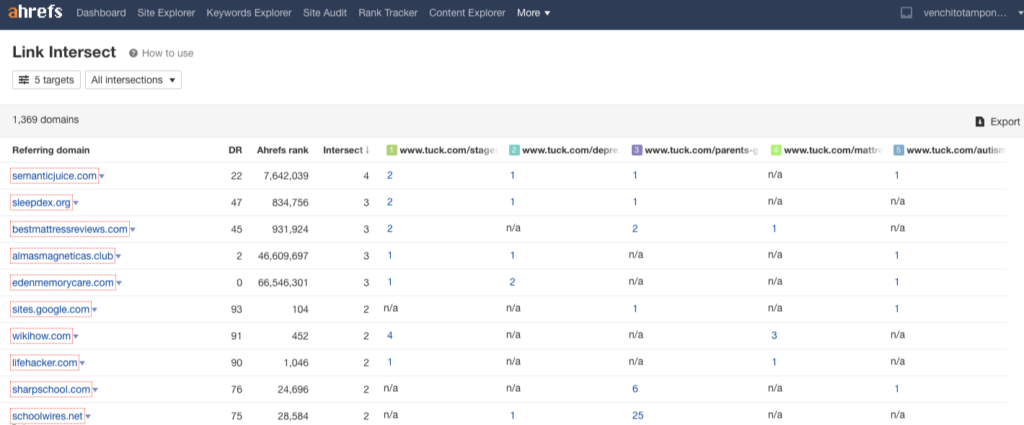
Then click “All Intersections” on the top section and only check 3 targets.
This would give you websites that linked to your competitor at least 3 times.
So these are your competitors’ top repeated linkers.
You do the exact steps I shared earlier to your other competitors, to also see their top linking websites.
Find your competitors' linkable content.
Any page that earns hundreds of backlinks or that have the potential to acquire more links can be considered as a linkable content.
Chances are your competitors have linkable content in place. You just have to know what those pages are.
For this specific activity, you can use Ahrefs to find linkable pages of your competitors.
Insert the domain URL of your competitor’s website to Ahrefs’ Link Explorer.
Then go to Best by Links.
Here, you’ll see the Best Pages by Incoming Links.
You can sort these pages from highest to lowest referring domains to see the highest linkable content.
By checking each of the page, you’ll see what types of content gets links.

Here are some tips for you:
- Create similar content. If there is a broken linkable content, you can also create a version of it. You can click on the drop-down button and click “view on Archive.org to see its latest version.
- Get all pages linking to a linkable page. Click on the drop-down button again and click “Backlinks”. Now, you’ll see all pages linking to the linkable page.
- Once you create similar content, reach out to all of the linking pages and ask them to link to your newly published piece.
- Do step 1 through step 3 to all of the top linkable content of your competitor.
Find your unearned links from competitors.
You may have to find all of the top linkers of your competitors, and even their linkable content, another strategy to steal your competitors’ backlinks is to find your unearned links.
What are these unearned links?
These are backlinks you’ve never earned for whatever reasons, such as you haven’t reached out to them yet or they haven’t seen your content as a good reference.
How to find your unearned links from competitors?
You use Ahrefs Link Intersect tool.
Get all your competitors’ domains
Insert them into Link Intersect one by one.
Then click on “all intersections”, either check only two or three targets, whichever you prefer. If you choose 3, it only shows you websites that linked to at least three of your competitors.
To get more results, I prefer to just choose two targets.
Now, you have a list of all these websites linking to your competitors.
Inverted Broken Link Building SEO Strategy
How to acquire hundreds of links by banking on a “dead page”
If you have never heard broken link building before, it’s basically a strategy wherein the steps are:
Step 1: Create a resource page for a linkable audience.
Linkable audiences could be students, parents, or job seekers.
Step 2: Find resource pages on the topic of your choice.
So if you have a resource guide for students, “How to Sleep Better for Students”, you wanna look for resource pages that can link to that page, either the page covers any “as a student tips or hacks.”
Step 3: Look for broken links on a page.
And see if there are links pointing to those broken links or pages.
Step 4: Get those existing links to broken pages.
And consider them as your backlink prospects.
Step 5: Reach out to the website owners.
Or people managing those broken pages and suggest your resource guide as a replacement to their broken links.
These five steps are what you normally do when you execute a typical broken link building strategy.
But let me show you a more effective way to do this - and this may be an advanced technique but it works pretty well if you want to maximize your efforts, time, and energy.
So here are the five steps.
How to Do Inverted Broken Link Building (SEO) Strategy
Step 1: Find broken pages you can recreate.
If a broken page has tons of links, you know for sure that you will get links. You actually find proof first before you invest in creating content. So many times, people would start with creating the content without really thinking if the topic of the content or the content itself has the potential to earn links as they promote it.
You can use Ahrefs’ Content Explorer to find content in your industry with backlinks to it.
Filter these pages by their http status, so you can only find 404 or broken pages.
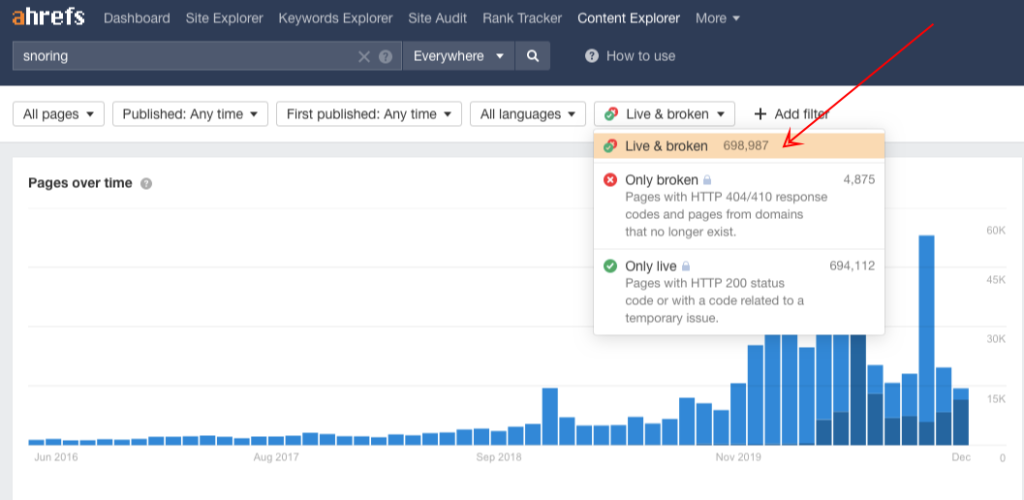
That leads us to step two, which is:
Step 2: Check the page’s linking domains.
Again, you want to make sure that the page that you want to recreate has proof of links. So go check it out using Link Explorer, again using Ahrefs, and see how man referring domains are linking to that broken page.
Step 3: Check the page’s original version using Wayback Machine.
You can use archive.org for this one.
So when you plugin the page into Wayback machine, you’ll then see its different versions. What you want to look at is its latest version (maybe broken at the moment you’re checking it, but the latest version when it was still live).
Now, you have the assurance that the topic or content you’ll be creating has the potential to get backlinks, the next thing to do is to create an improved version of that broken page.
Step 4: Create an improved version of the broken page.
So go again and check the old version of the page and see how you can recreate it in such a way that the information is more updated, with more graphics and videos if you can add those things. Just make sure that the new page is a more comprehensive one than its old broken version.
The last is to reach out to the linkers of the old page. Given that you know there are existing links to the broken page, what you can just do now is to list them down in a spreadsheet.
So send them outreach emails suggesting your new content as a replacement to the broken link on their page.
How to Find Journalists to Cover Your Stories
How to find journalists who are looking to cover your stories without paying expensive PR tools like HARO.
By the way, you can use HARO. There’s nothing about the platform. But there is a way to find journalists and publishers without you even going to HARO.
It's a very simple platform where you only need is to have a list of phrases to search for, and there you'll see journalists, news writers, and publishers who could cover your story.
That platform, guess what? Is your social media platform - Twitter?
Yes, that’s right. Twitter.
So on Twitter, people are posting what they need - what they’re looking for. So in most cases, journalists, news writers, and publishers are using their Twitter accounts for work -- specifically looking for brands, and personalities who have interesting stories they can cover on their websites.
Now what you want to do is to use specific queries to find these journalists.
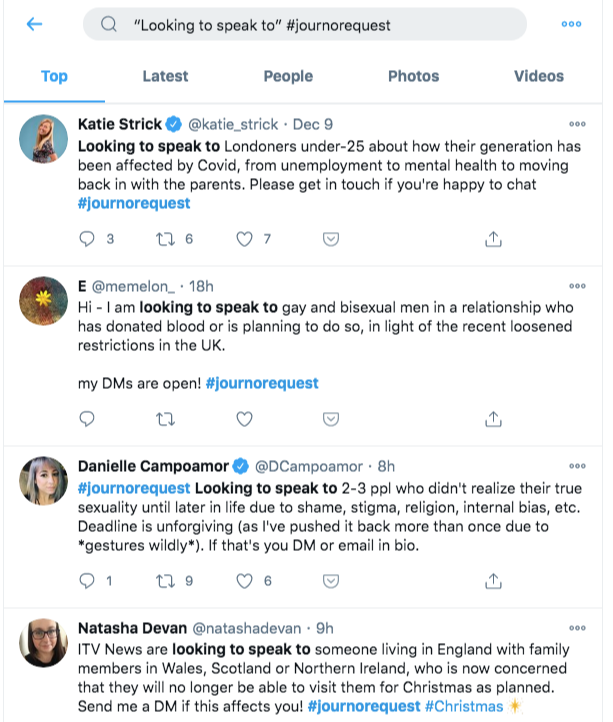
Examples of keywords you can use for Twitter search:
- “Looking to speak to” #journorequest
- “Looking to interview” #journorequest
- “Is there anyone” expert #journorequest
- “Can you recommend” interview #journorequest
If you notice, these are phrases they naturally use when finding people they can interview. Questions like is there anyone or can you recommend?
By using natural questions as part of your keywords, you’ll get more searches when finding journalists to cover your story.
7 Content Promotion Strategies (That Actually Work)
When it comes to content promotion, the first to get started is not knowing what channels to promote your content in, but rather having an understanding of your content piece.
Before you promote your content, you have to know what makes your content valuable.
The question you need to ask yourself is, “what makes your content valuable?”
Because if you see the value of your content, you can easily write captions for social media posting, you can easily write email templates to promote it to a cold audience, and even easily target the right audience -- because in the first place, you’ve identified what value your content offers.
Find that value proposition.
Now, here are 7 effective content promotion strategies that actually work.
Audience Banking
First is through audience banking.
That is reaching out to your existing audience - this could be on social platforms or to your email list - if you have one.
You may have an existing following on social media services like Facebook, Linkedin, Twitter.
Start promoting your newly published content to your social followers.
The key here is to promote your content based on the context of the platform.
You don’t copy and paste the same stuff you post on one platform to another platform. On Twitter, you’re likely to see preview-like captions to describe what the content is about in a gist.
On Facebook, long-form caption writing may work best for you. As people tend to read more long-form captions today on that platform.
Know the context of the platform, and think of how you can best serve your audience with your content promotion strategy.
Community Engagement
Second is community engagement.
Community engagement means you don’t go to a Facebook group and quickly post a link to your content.
Remember that community groups are more strict today than before. They have guidelines for posting to follow.
So it is best to have a few groups where you can engage with other audiences.
Find community groups where your audience hangs out.
On Facebook, you can quickly search for which group you can engage in. Same with Linkedin.
There are particular premium slack groups where you’ll get the most value from audience insights.
The key to promoting your content in all of these groups is to think of value giving than just value getting.
If there are questions that are relevant to what you’re doing, answer it with value. And if there is a resource that you think might be helpful for the audience, include a link to your content.
External Content Contribution
The third effective content promotion method is external content contribution.
What you’ll do here is create content for other websites to promote your content on your blog.
How is that possible?
When you write content for other blogs, you include a backlink to your content on your blog.
This is often referred to as “guest blogging”.
When writing guest posts, be sure to consider these 5 simple tips:
- Who is their audience? Who are the people they’re writing for?
- What topics will best serve their audience?
- Can I write about those topics?
These three questions can guide you towards creating external content for other websites to promote your content that’s in your blog.
Alliance Building
Another content promotion strategy that really works is alliance building.
Alliance building means that you know who are your networks going online.
If you’re marketing an eCommerce site, who are your partner retailers, manufacturers, or suppliers you could reach out to promote your content?
Here’s the thing: it’s easy to promote content to a person who knows and trusts you.
So why not start with people you’ve known for months and years, and send them an email, telling them of your latest guide, infographic, or resource.
Start by having an inventory of your friends and networks working in the same industry as yours.
You can create a spreadsheet to track these people. Find their email addresses. Send them outreach emails. This leads us to the 5th content promotion strategy.
Cold outreach
If you don’t have an audience yet, this is the content promotion method for you.
If people don’t know you, then let them know you exist and your content exists.
So start looking for people who might be interested to link or share your content.
One good strategy here is to know publishers who’ve created similar content and see who has shared or linked to their content.
So if I am writing a piece about a sleeping guide for kids. I want to know who are other publishers created a sleeping guide for kids.
So I go on Google and type in, “sleep guide for kids”.
Here, I see different pages for that same topic.
Then if I want to know who are the people who linked to those pages, I can use a tool like Ahrefs to find who linked to those pages.
Given if they linked to a page similar to my content, they’d be more likely interested to see, share, or link to my content as well.
Dream 100 Promotion
Have you ever wondered how others get more attention quickly even if they’re just starting out?
The reason is that they associate themselves with influencers and thought-leaders in the industry.

These influencers and thought-leaders are your dream 100. They are the top 100 personalities in your industry.
If you leverage other people’s influence, you attract more eyeballs and get more massive attention than what a usual marketer can get.
But one question that will arise is this:
How could they interact with thought-leaders and top industry practitioners if they’re not of the same level?
You don’t send them spam messages to do a favor for you without even providing them with value first.
Here are some examples of the value you can give to your dream 100:
- Free product/service (e.g. 6-month access to a SaAs premium tool plan)
- Interviews (e.g. guest on your show featuring industry experts)
- Free content format (e.g. infographic version of their top blog post)
Start promoting your content pieces to Dream100 by giving them initial value.
Ad Retargeting
The next effective content promotion strategy is ad retargeting.
Basically, Ad retargeting is creating ads to target people who’ve visited your website.
Because they’ve known about your brand or content, the cost of your ads would be much lower than if you target a cold audience.
Ad retargeting is hitting warm audiences, which is an effective strategy to constantly build up your audience by showing your ads to people who are familiar with your website.
Start setting up your Facebook pixel. There are many tutorials on Google that show you how to do that. Then start creating ads to retarget website visitors.
How to Use Where to Buy Pages for eCommerce Link Building
The eCommerce strategy to build backlinks to money pages without paying bloggers.
It’s actually one of the overlooked strategies when building links to online stores...and this is targeting where to buy pages.
Where to buy pages are basically pages where people search for places to find products or services. It includes lists of retailers, suppliers, affiliate partners, or anyone who distributes products you’re selling.
In different industries, there are where to buy pages that you can find. In the health industry, we have examples like “where to buy” diabetes care products.
In the transportation space, there are where to find transport options page, where people could just check the page and see what are the available options for traveling to and from the place.
You can also be as local-specific here like there are transport options page Adelaide (if you’re in Australia).
In the music industry, there are middle school and college websites that have vendors list pages. They have pages dedicated to sharing vendors of musical instruments with links pointing to each of their websites.
What you want to do is to check these link opportunities -- where to buy pages in your industry.
So start with knowing your current and potential partners.
Who are your manufacturers? Who are your retailers? Who are your distributors? Make an inventory of these people, these brands. You also want to check if they have their own websites, and if they have “where to buy” pages on their sites.
To see that, you can use advanced search operator, site colon:domain of the site. space, where to buy, For example, site:onlineshop.com “ where to buy.
You can also add more to your list by first checking your product categories. If you own a music online store, you have product categories like violin, viola, double bass.
Then check on Google to see if there are where to buy pages for those product categories.
Find where to buy opportunities with product categories, so you can do a Google search for “PRODUCT CATEGORY” inurl:links
For example, “classical instruments” inurl:links.
You may also go as specific to your product, and not just product category.
So here are some keywords you can use for that specific purpose.
- where to buy INDUSTRY OR PRODUCT
- online retailers INDUSTRY OR PRODUCT
- online dealers INDUSTRY OR PRODUCT
- find our products INDUSTRY OR PRODUCT
- additional retailers INDUSTRY OR PRODUCT
- internet resellers INDUSTRY OR PRODUCT
- preferred retailers INDUSTRY OR PRODUCT
Vary it on your partner type and your industry.
Once you have the list, go and ready to reach out to them and let them know that you distribute one of their products (if you’re a retailer or distributor) or get them to include a link to your product or product category page (if it’s a resource page).
How to Get Quality Backlinks With This HR Strategy
There is one thing that HR people do every day that can help you generate high-quality backlinks.
And that is using job boards to hire people.
You won’t do the hiring here. But you will use HR assets online to be able to get backlinks to your website.
Here is how you can start.
Find job boards list in your local city
There are resource pages that list down all of the available job sites and job boards within a local city or area.
For instance, there is a job board list page for anyone looking for work in Massachusetts. On that list, you’ll see different career websites and specific job board links from brands looking for hires.
This link building strategy is mostly applicable to startups, particularly tech companies.
There are a lot of job boards list pages that you can find online. Here are some keywords that you can use to find them:
- “Job search” “resources” “CITY”
- employment” inurl:resources “CITY”
- “job hunting” resources “CITY”
- inurl:careers “CITY”
Let’s say you have a job board list on your site. What you can do now is offer your job board as an additional resource to prospected resource pages.
When you do outreach, simply make a suggestion for your resource page. You’re not coming off as someone pushing them to link to you. Making a quick suggestion is a more effective strategy than pushing these people to link to you.
How to Find Someone’s Email Address (In Seconds)
Today, I’m going to show you how to look for someone’s email address with supreme accuracy without spending minutes finding it.
Step 1: Use Voila Norbert
Once you have an account, you can use it quickly. Landing on a website,
Voila Norbert is a free chrome extension tool that helps you find email addresses in seconds.
So install hunter to your chrome extension.
Once installed, it’ll appear in your Chrome toolbar.
So when you landed on a website, you click on it. And now you have to enter the prospect’s name and the domain of the website. Then click “Go ahead, Norbert”.
In as fast as 1 second, you’ll quickly see if there is an email attached to the domain.
You can best use Voila Norbert for single-author sites or blogs if you know the specific name of the person you’re reaching out to - which you can quickly see on the blog’s About page.
But for larger companies, you may want to contact a specific person like the content marketing manager or editor in charge of the blog.
Step 2: Try Hunter
Go to Hunter. Create an account.
When you landed on a website, you can quickly find email addresses associated with the domain by clicking Hunter tool in the toolbar.
Now, you’ll have a list of email addresses to choose from, depending on who you want to reach out to.
So let’s say for this website: siegemedia.com; I want to find the content manager.
And by clicking Hunter, it quickly shows me this person to reach out to for email outreach.
Step 3: Find it on About or Contact page
Not all email addresses are hosted in domains.
There are non-domain.com email addresses, such as Gmail accounts.
Here are ways to find these non-domain.com email addresses.
First is to check the website's About or Contact page.
Oftentimes, small blogs or websites will just leave their contact details there.
Step 4: Utilize site advanced search operator
Another way to find non-domain emails is by using a search operator: site:domain.com and then “gmail.com”
Google this exact search, then you’ll be able to see on the meta description in one of the pages in the search results - the exact gmail address.
Step 5: Search Twitter Feed on Google
Another email hunting approach is to first, find the Twitter handle of the author.
Then do a Google search for:
site:twitter.com/twitterhandle/status
And then some footprints like gmail.com or yahoo.com or hotmail.com or anything else.
There you’ll see the Gmail address included in one of the author’s tweets.
Start Email Hunting Today
So those are email hunting approaches that you can use to find email addresses in seconds.
The next thing you also want to do is to verify the email addresses you’ve collected.
For domain-email addresses, you get to see if the email address is verified when you use Hunter or Voila Norbert.
For non-domain email addresses, you may have to use email verification tools.
Email verification tools like Never Bounce and Verfiy Email Address.org are some recommended websites where you can verify your collected email addresses.
The #1 Question You Need to Ask Yourself When Doing Email Outreach
Why should they care?
This is the #1 question you need to ask yourself when crafting an outreach email. This is huge. And if you ask this question before you write your outreach template, you know that it'll significantly impact your response and conversion rates.
Most people would start with copying and pasting outreach templates they saw on Google. The thing is it the outreach copy doesn’t match first to what you offer, you’re missing the opportunity to highlight your offer and what it does to your target prospect.
Why should your prospects care? What is it in your content they have to pay attention to? Is it something they can distribute on their web properties like blogs or email lists wherein their audience can find value in it.
Highlight in your pitch the answers to this question “what’s in it for your backlink prospects?”
Content Gap Analysis in Guest Blogging
The first link building strategy is using content gap analysis in guest blogging.
Have you ever received this kind of email? People sending you a pitch for your blog without even having any specific topics. Or even if they sent you topics, they're mostly generic and not thinking of your audience.
This is what we want to avoid, right?
So the first step to pitch topic ideas that your prospects' audience actually need.
You can use Ahrefs, it's an SEO tool that has this Content Gap feature. So what it does is it helps you find keywords that you don't rank, but other websites are targeting and ranking.
So given we are using for guest blogging purposes, you want to look for keywords that your guest blog isn't ranking yet, but its competitors are ranking already.
So now once you pitch to that blog. You don't offer any generic topics. But rather list of topics brainstormed from keywords you know they have the tendency to rank.
And here's the good thing. The moment your topic was accepted, you submitted your guest content, and because it is targeted to a specific keyword, it now has the tendency to rank for its keyword. And once it ranks, your guest post gains more visibility. It gains more eyeballs from the blog's target audience. And given you have a link from the guest post, you can receive constant referral traffic.








